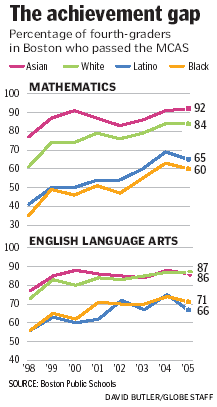Latinos and blacks lag on the Massachusetts Comprehensive Assessment System exam
Tracy Jan:

Not one Boston elementary school is significantly boosting the scores of black and Hispanic students on the state's English and math tests, renewing concerns that the schools have made no headway in narrowing the achievement gap between those students and whites and Asians, according to a report announced last night.
At only a handful of elementary schools, the performance of black and Hispanic students on one of the state MCAS tests improved in 2005, compared with 2004, said Boston School Department officials, who delivered the report last night at a School Committee meeting.
They added that none had reported progress on English and math measures, said school officials.
The gap in achievement between blacks and Hispanics and other elementary students has not narrowed since the Massachusetts Comprehensive Assessment System exams were first given in 1998, school officials say.
Boston's lack of progress with African-American and Hispanic students during the tenure of Superintendent Thomas W. Payzant has become a key sticking point at recent community forums, at which parents, educators, and others have described what they want from the next superintendent after Payzant retires.
Overall, MCAS scores have improved during Payzant's tenure, but the report released yesterday highlighted a need to do more to raise the performance of blacks and Hispanics, who make up the majority of the 58,600 students in the school system, school officials and others said.
"This sets the stage for the future," said Theresa Perry, an education and African studies professor at Simmons College and an author of books about the achievement gap. "Unless the achievement gap is eliminated in elementary school, it sets up a two-tiered system in Boston, a system that leads to opportunity for white and Asian kids and limited opportunity for black and Latino students."
Yesterday's report is the second that the school system has done since 2004 in an effort to track the progress of each racial and ethnic subgroup of students, as well as that of special education students and of English-as-a-second-language students. Black and Hispanic students made greater gains districtwide between 2003 and 2004, according to district data.
Schools that have made progress did so by scrutinizing the test data and changing teacher practices, Payzant said. "They're paying attention to it," he said.
The school system measured improvement by judging how much progress students were making toward achieving proficiency on the MCAS tests.
The tests signify that they are performing at their grade level. The federal No Child Left Behind law requires school systems to ensure that all students, regardless of their backgrounds, become proficient in reading and math by 2014, as measured by state tests.
In 2005, only about 20 percent of Boston's black and Hispanic fourth-graders scored "proficient" or above on the English MCAS tests, compared with almost 50 percent of their Asian and white peers, according to school system data.
The gap also exists for the percentage of fourth-graders who passed the test with a "needs improvement" score, the minimum requirement; close to 90 percent of white and Asian students passed the English test, compared to about 70 percent of black and Hispanic students. That gap of roughly 20 percentage points has held steady since 1998.
Statewide, 27 percent of blacks and 22 percent of Hispanics scored "proficient" or above on the 2005 fourth-grade English test, compared with 56 percent of white students.
Special education students were the only group districtwide to make significant improvement on the MCAS tests in the last year.
Meanwhile, English-as-a-second-language students showed the least improvement, the report said.
At higher grades, only one high school and one middle school made significant progress in 2005 in raising the scores of all subgroups of students on both state tests, the report said.
"This is a problem that is across all levels of schools," said Barbara Fields, senior officer for equity in the Boston public schools.
The gap in achievement shows in other areas in the school system: Fewer black and Hispanic elementary students are getting into advanced classes that prepare them for the city's exam schools, and more black and Hispanic students drop out of high school.
Fields and other administrators said the school system made closing the achievement gap a priority two years ago. The district has trained principals and teachers on developing high expectations for all students, teaching to different learning styles, and finding connections with students and their families from various cultural backgrounds.
At the Winthrop Elementary School in Dorchester, where 97 percent of students are black or Hispanic, an independent consultant began training teachers last September on developing high expectations of students. Principal Emily Shamieh and teachers met with 75 parents on a Saturday, asking the parents to describe the dreams they had for their children and to discuss ways to overcome the obstacles.
Only 20 percent of black students and 10 percent of Hispanic students at the Winthrop scored "proficient" on the 2005 English MCAS. In math, 7 percent of blacks and 5 percent of Hispanics scored "proficient."
Whose Gap in Achievement?
Martin Luther King Jr. Honored In Boston
NYS education summit: Closing the achievement gap






0 Comments:
Post a Comment
<< Home